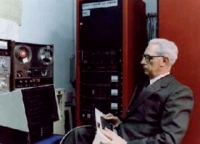
Composers
- bio
Daniele Lombardi, piano
Pietro Grossi was born in 1917 in Venice. He started his musical studies in 1925 at the Conservatory of Music of Bologna where he took his degree in cello (1935) and composition (1941). From 1936 to 1966 he was the first cellist of the Maggio Musicale Fiorentino orchestra; in the meantime he continued his activity as a performer. From 1942 to 1985 he worked as a professor at the Conservatory of Music of Florence where he taught cello and electronic music, organizing also seminars and special courses of computer music. In 1961 Intern2 established the Vita Musicale Contemporanea association and in 1963 he decided to create the S 2F M studio (Studio di Fonologia Musicale di Firenze) in Florence.
In 1967 he made the first experiences in computer music; in 1969 he promoted the creation of the computer music division of CNUCE (Institute of the National Research Council of Pisa) and in 1970 he showed his first software package devoted to computer music at the Contemporary Music Festival in Venice. In the same period he made his first approaches to musical telematics organizing a performance with a link between Rimini (Pio Manzù Foundation) and Pisa (CNUCE).
For a long time he has been the head of the above-mentioned computer music division of CNUCE, carrying out researches on the following fields: computational musicology, automated composition, design of sound-synthesis systems and musical telematics. In the middle of the Eighties, Intern2 has started a series of researches concerning computer graphics. The Homeart (term coined by himself) project is particularly relevant: it consists of completely automated visual processes, based on simple computer programs, where he gives space to randomness in the context of a single compositive idea, developed into many different graphic variations.
The last step of his artistic career is the creation of a series of "unicum" books, electronically produced and symbolically called homebooks: each work is completely different from the others, thanks to the strong flexibility of the digital means.
